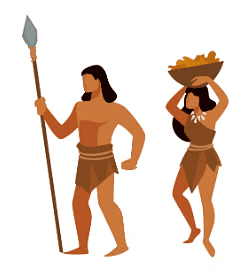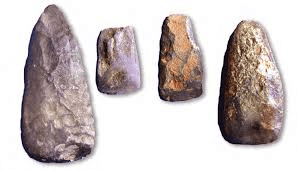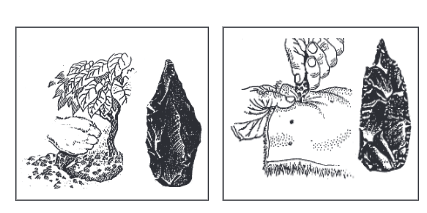NCERT Solutions for Class 6 History - From Hunting - Gathering to Growing Food
Let’s Recall
Q1. Complete the sentences
(a) Hunter-gatherers chose to live in caves and rock shelters because _____________.
Ans: Hunter-gatherers chose to live in caves and rock shelters because they discovered shelter from the sun, wind, and rain.
 View Answer
View Answer- Caves and rock shelters provided natural protection from environmental elements.
- These structures offered a safe and stable environment where hunter-gatherers could escape harsh weather conditions, such as extreme sunlight, rain, and wind.
- Additionally, these locations often had access to resources such as water and game, making them ideal for early human habitation.

Hunter-gatherers
(b) Grasslands developed around ______________ years ago.
Ans: 12,000 years
 View Answer
View Answer- The development of grasslands is linked to significant climatic changes during the end of the last Ice Age.
- As temperatures began to rise, forests receded, and open grasslands expanded.
- This transformation allowed for the evolution of new ecosystems that supported various animal and plant species.
- The emergence of grasslands played a crucial role in human history, as these areas became prime locations for hunting and eventually led to the domestication of plants and animals, shaping agricultural practices.
Q2. Why do people who grow crops have to stay in the same place for a long time?
Ans:
- To grow crops, people need to stay in one place for a long time. This is because they must take care of the plants, protecting them from birds, animals, and even other people.
- They also need to water the plants, remove weeds, and make sure the crops grow properly. Depending on the type of seeds, it can take days, weeks, months, or even years for them to sprout and ripen.
- Once the crops are ready, they must figure out how to store the harvested grain. This process of staying in one place to tend to crops is essential for leading a settled and civilized life, as it provides food and meets other daily needs.
 Adivasis
Adivasis
Q3. Why do archaeologists think that many people who lived in Mehrgarh were hunters to start with and that herding became more important later?
Ans: Archaeologists think that many people who lived in Mehrgarh were hunters at first and started herding later for a few reasons:
- Early Tools: The oldest tools found in Mehrgarh, from about 7000 BCE, are used for hunting. This shows that people were mainly hunters and gatherers back then.
- Wild Animals: The area had many wild animals, making it easy for people to hunt for food.
- Change Over Time: As time went on, people began to settle down and started domesticating (raising) animals like sheep and goats for food.
- New Ways of Living: Later, they found storage places for food, which means people were living in one place for longer periods and needed more food sources.
- Growing Communities: As communities got bigger, they started farming and herding more, which changed their way of life.
So, while hunting was important at first, herding and farming became more important as the people of Mehrgarh learned to live in one place.
Let’s Discuss
Q4. Why did the hunter-gatherers travel from place to place? In what ways are these similar to/different from the reasons for which we travel today?
Ans: Hunter-gatherers moved from place to place for several reasons:
- Food Scarcity: If they stayed in one place too long, they would exhaust the local supply of plants and animals, requiring them to move to find new food sources.
- Following Animals: Animals moved in search of food, and hunter-gatherers followed them to hunt. For example, they might follow herds of deer or wild cattle.
- Seasonal Changes: Different plants and trees bear fruit at different times of the year, so people moved to find the fruits and plants that were in season.
- Water Availability: Water was essential for survival, and since not all water sources were permanent, they had to move to find water during dry seasons.
 New Stone Tools
New Stone Tools
Similarities and Differences with Modern Travel:
- Similarities: Just like hunter-gatherers, people today often travel for essential needs, such as food (grocery shopping) or water (visiting areas with better water quality). Additionally, people might move seasonally, such as migrating to warmer places during winter.
- Differences: Unlike hunter-gatherers, modern travel is more often for leisure, work, or exploration rather than survival. Today, we have settled homes, and most people do not need to move frequently to find food or water, as these resources are readily available in one place. Technology and infrastructure have also made travel faster and more convenient.
Q5. List three ways in which hunter-gatherers used fire (see page 14). Would you use fire for any of these purposes today?
Ans: It was primarily used for 3 purposes:
- Clearing forest area
- Cooking
- For protection from wild animals
Nowadays, we use fire:
- To keep ourselves warm
- For cooking
Q6. List three ways in which the lives of farmers and herders would have been different from that of hunter-gatherers.
Ans: Three ways in which the lives of farmers and herders would have been different from hunt-gatherers are:
- Hunt-gatherers keep moving from place to place in search of food while farmers and herders grow their food from their living place.
- Hunt-gatherers did not build any permanent houses mostly they live in caves while farmers and herders build huts and houses.
- Hunt-gatherers had no role in protecting animals and plants while farmers and herders protect animals and plants.
 Stone tools used for digging
Stone tools used for digging
Let’s Do
Q7. List the cereals that you eat. Do you grow the cereals you eat. If yes, draw a chart to show the stages in growing them. If not, draw a chart to show how these cereals reach you from the farmers who grow them.
Ans: Some cereals eaten by us are listed below:
- Wheat
- Rice
- Barley
- Black gram
- White gram
- Maize
- Lentil
- Peas
- Pulses
- Millet
|
69 videos|386 docs|80 tests
|
FAQs on NCERT Solutions for Class 6 History - From Hunting - Gathering to Growing Food
| 1. What were the main activities of hunting-gathering societies? |  |
| 2. How did the transition from hunting-gathering to farming change human societies? |  |
| 3. What are the advantages of farming over hunting-gathering? |  |
| 4. What crops were commonly grown during the early farming period? |  |
| 5. How did the domestication of animals contribute to the development of agriculture? |  |























